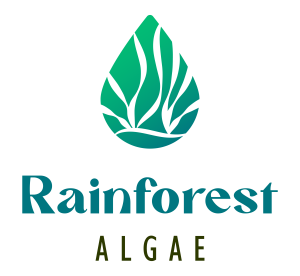Media Release – September 2025.
Effecting Enhanced Mass Gas Transfer Between Liquid & Gas Phases To Increase Reaction Rates and Reduce Energy Requirements

Stan Pankratz
Founder / President
Rainforest Algae Corp. is a technology company with an early mandate to double the known yield of algae. This milestone was achieved at bench scale in 2022, after which efforts shifted to scaling the technology toward commercial and industrial applications.

Technology Readiness Level (TRL) 6
The platform has now advanced to Technology Readiness Level (TRL) 6, with a fully functional prototype validated in simulated laboratory environments.
The company has been awarded two patents:
- WO 2023/023854 A1: A System and Method for Enhancing Gas Mass Transfer
- US 2024/0350988 A1: A System and Method for Generating Nanobubbles
It is the combination of these innovations—the patented rotating bioreactor and the integration of nanobubbles (NBs)—that enables extraordinary gas mass transfer efficiencies. This breakthrough effectively breaks the long-standing “glass ceiling” of gas–liquid exchange, unlocking yield improvements across biological, metabolic, fermentation, photosynthetic, heterotrophic, autotrophic, and chemical systems.
Nanobubbles: A New Frontier in Gas–Liquid Interaction
Nanobubbles (NBs) are gas-filled cavities in aqueous media with diameters typically around ~100 nm. Though only recently studied in depth, they display remarkable properties:
- Stability in water: Persisting for months rather than collapsing within seconds like conventional bubbles.
- Gas supersaturation: Capable of holding >20× more dissolved gas than bulk liquid, effectively pushing solubility limits.
- High surface area-to-volume ratio: Allowing rapid gas transfer.
- Negligible buoyancy: Preventing them from rising out of solution.
- Enhanced diffusion: Even a small NB fraction accelerates overall mass transfer, since gas diffusion rates are ~100,000× higher than in liquid.
Collectively, these features allow NBs to serve as both reservoirs and accelerators for gas–liquid reactions.
Cross-Industry Applications
The ability to super-saturate liquids with gases opens transformative opportunities across industries, including:
- Wastewater treatment (municipal, agricultural, aquacultural, process water) – aeration accounts for 55–70% of energy use (NB systems already being piloted). Methane reductions, massive energy reductions.
- Environmental remediation & carbon capture – enabling high-efficiency absorption of CO₂ and other gases.
- Chemical energy storage & processing – improved kinetics in fuel synthesis and chemical conversions.
- Food, brewery, and agriculture – enhancing fermentation, crop growth, and preservation processes.
- Algae cultivation – demonstrated yield breakthroughs in both autotrophic and heterotrophic systems for nutrient supplements, nutraceuticals, energy feedstocks, pharmaceuticals, fertilizers,
- Mining & materials – tailings treatment, low-carbon cement, friction reduction, extraction of metals.
- Healthcare & biotechnology – respiratory therapies, drug delivery, and diagnostics.
- Aquaculture – improving water quality, minimizing fish mortality, feed for shellfish, maintaining high oxygen water levels, buffering water pH.
Overcoming the Limitations of Nanobubble Generation
Historically, NB technology has been limited by energy-intensive generation methods (mechanical or electrolytic), low concentrations, and poor scalability. Rainforest Algae Corp. has addressed these barriers with a novel electric-field–based approach that reduces energy requirements by ~1000-fold compared to conventional methods while enabling higher NB concentrations.
Competing NB technologies exist—Moleaer, for example, reports delivering 1000 GPM of NB-rich water at 25 kW—but Rainforest’s current designs project up to 100× lower energy consumption and the potential for 100× higher NB concentrations.
Synergy with the Patented Rainforest Rotating Reactor
Beyond NB generation, efficient gas exchange must occur at the liquid–gas interface. The Rainforest rotating bioreactor creates a constantly renewing surface area that maximizes gas transfer efficiency. This design allows gases within NBs to equilibrate rapidly with reactor headspace gases according to Henry’s Law, without the need for conventional bubbling systems.
The absence of bottom-up gas sparging avoids common issues such as foaming while improving energy efficiency. This represents a fundamental departure from traditional photobioreactors and gas transfer systems, opening a new design paradigm in reactor engineering.
Enabling the Circular Economy
At industrial scale, Rainforest Algae Corp.’s platform can enable:
- Competitive biofuel, protein, and lipid production compared to conventional agriculture and petroleum-derived products.
- Scalable cellular agriculture, reducing reliance on animal-based inputs.
- Closed-loop wastewater treatment, reclaiming valuable metals and nutrients while removing contaminants.
- Carbon footprint reduction, directly supporting climate change mitigation and the transition to a circular economy.
Collaboration and Next Steps
With TRL 6 validation achieved, Rainforest Algae Corp. is actively pursuing collaborations to advance pilot and industrial-scale deployments. The simplicity of the system’s integration makes it attractive for retrofitting existing processes across multiple sectors.
We invite partners across biotechnology, energy, agriculture, aquaculture and environmental industries to engage with us in advancing next-generation gas–liquid transfer solutions that reduce energy demand, increase reaction yields, and accelerate the transition toward a sustainable economy.
We look forward to hearing from you soon.
Stan Pankratz
Founder & CEO






